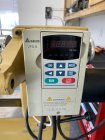- Joined
- Nov 3, 2008
- Messages
- 41
- Likes
- 1
I just bought a used Powermatic 3520 lathe went to the guys house he ran the lathe for me and we loaded it up I drove it home about nine hours away put it back together plugged it in and nothing
There is power to the VFD I tested that, but none of the lights come on and it will not run any idea what this could be?
There is power to the VFD I tested that, but none of the lights come on and it will not run any idea what this could be?

